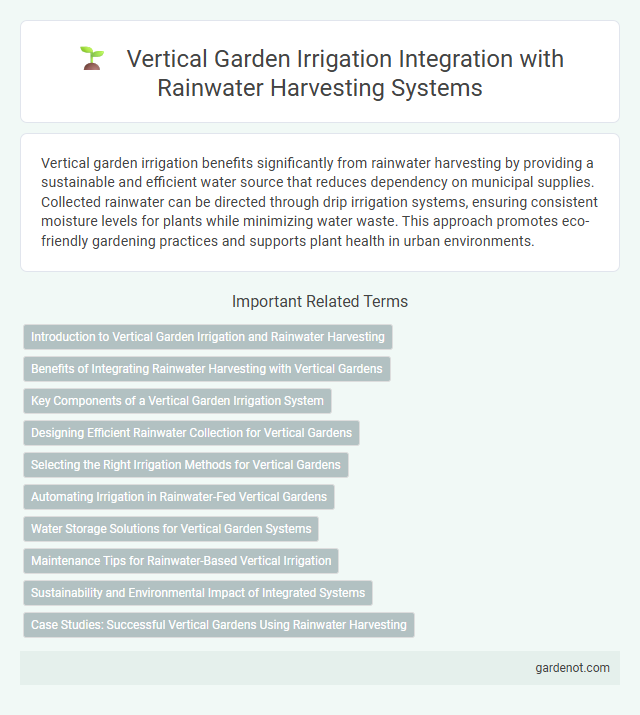Vertical garden irrigation benefits significantly from rainwater harvesting by providing a sustainable and efficient water source that reduces dependency on municipal supplies. Collected rainwater can be directed through drip irrigation systems, ensuring consistent moisture levels for plants while minimizing water waste. This approach promotes eco-friendly gardening practices and supports plant health in urban environments.
Introduction to Vertical Garden Irrigation and Rainwater Harvesting
Vertical garden irrigation leverages rainwater harvesting systems to efficiently supply plants with natural, sustainable water sources, reducing dependency on municipal water. Integrating rainwater collection with drip or micro-spray irrigation optimizes water use by delivering moisture directly to plant roots, enhancing growth in limited spaces. This eco-friendly approach promotes conservation, lowers water bills, and supports urban greening initiatives.
Benefits of Integrating Rainwater Harvesting with Vertical Gardens
Integrating rainwater harvesting with vertical gardens significantly reduces water consumption by utilizing stored rainwater for efficient irrigation, promoting sustainable water management. This eco-friendly approach enhances plant health and growth while lowering dependence on municipal water supplies, resulting in cost savings. Additionally, harvested rainwater minimizes runoff and erosion, contributing to improved urban drainage and environmental conservation.
Key Components of a Vertical Garden Irrigation System
A vertical garden irrigation system primarily includes a water source, such as harvested rainwater, a distribution network composed of drip lines or micro-sprinklers, and a filtration unit to prevent clogging. Key components also feature a pump to regulate water pressure and timers or sensors for automated watering schedules, ensuring optimal moisture levels. Incorporating moisture sensors enhances efficiency by adapting irrigation based on real-time soil moisture data, thus promoting sustainable water use.
Designing Efficient Rainwater Collection for Vertical Gardens
Designing efficient rainwater collection for vertical gardens involves optimizing surface area and incorporating gutters or drip irrigation systems directly into the structure. Utilizing rainwater harvesting tanks with filtration ensures clean water supply, reducing dependence on municipal sources and minimizing runoff. Integrating smart sensors can regulate water distribution, maximizing plant hydration while conserving harvested rainwater.
Selecting the Right Irrigation Methods for Vertical Gardens
Selecting the right irrigation methods for vertical gardens is essential to maximize water efficiency and ensure plant health in rainwater harvesting systems. Drip irrigation and micro-sprinklers are ideal for vertical gardens due to their precise water delivery and minimal runoff, allowing optimal absorption of harvested rainwater. Integrating automated sensors further enhances irrigation efficiency by adjusting water flow based on soil moisture and weather conditions.
Automating Irrigation in Rainwater-Fed Vertical Gardens
Automating irrigation in rainwater-fed vertical gardens optimizes water usage by integrating sensors that monitor soil moisture and weather patterns, triggering watering only when necessary. Smart drip irrigation systems distribute collected rainwater efficiently, reducing waste and promoting plant health in vertical setups. This technology enhances sustainability by minimizing reliance on municipal water supplies and maximizing the benefits of harvested rainwater.
Water Storage Solutions for Vertical Garden Systems
Vertical garden irrigation relies heavily on efficient water storage solutions such as rainwater tanks and modular reservoir systems specifically designed to maintain moisture levels. Integrating rainwater harvesting with these storage options reduces reliance on municipal water, lowers water bills, and ensures a consistent water supply during dry periods. Advanced water storage units equipped with filtration or gravity-fed drip systems optimize water delivery, promoting healthy plant growth and sustainable vertical gardening.
Maintenance Tips for Rainwater-Based Vertical Irrigation
Regularly inspecting drip emitters and filters prevents clogging and ensures efficient water flow in rainwater-based vertical garden irrigation systems. Flushing the system before the rainy season removes sediment buildup from harvested rainwater, maintaining optimal performance. Using biodegradable cleaning agents for occasional filter maintenance protects plant health while extending the lifespan of irrigation components.
Sustainability and Environmental Impact of Integrated Systems
Vertical garden irrigation using rainwater harvesting significantly enhances sustainability by reducing reliance on municipal water supplies and minimizing runoff pollution. Integrated systems capture and store rainwater efficiently, promoting water conservation and supporting urban biodiversity through green walls. This approach lowers energy consumption associated with traditional irrigation and contributes to mitigating urban heat island effects, fostering a healthier environment.
Case Studies: Successful Vertical Gardens Using Rainwater Harvesting
Vertical garden irrigation systems integrated with rainwater harvesting have demonstrated significant water savings and enhanced plant growth, as evidenced in case studies from Singapore and urban India. These projects utilized rooftop rainwater capture combined with drip irrigation, reducing municipal water use by up to 70% while maintaining lush, healthy greenery. Data from these successful vertical gardens highlight the effectiveness of rainwater harvesting in promoting sustainable urban landscaping and reducing stormwater runoff.
Vertical garden irrigation Infographic

 gardenot.com
gardenot.com